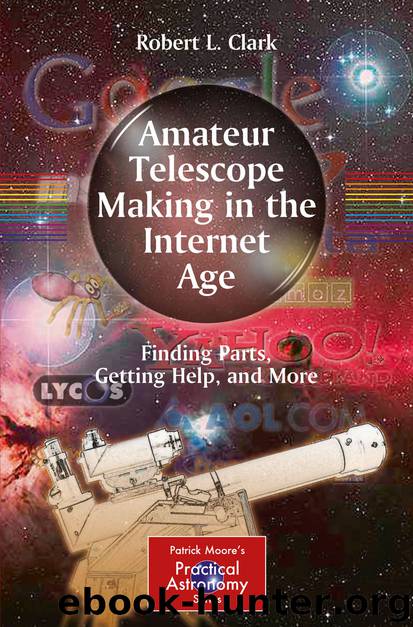Amateur Telescope Making in the Internet Age by Robert L. Clark

Author:Robert L. Clark
Language: eng
Format: epub
Publisher: Springer New York, New York, NY
The rocker attached to the finder is shown in Fig. 8.5.
Fig. 8.5This picture shows the entire mounting and finder attached to the f9 Newtonian
We have shown two easy ways to attach a finder. Take your choice or invent another. Chapter 4, describing the little 80 mm refractor, also illustrates the attachment of a finder to the main tube. In that case the actual attachment is accomplished with a hose clamp. Notice that the rocker actually looks like a rocker.
However you make the attachment it is important to have your finder mounted on the main telescope in a way that does not interfere with the balance. Do your balancing with the finder attached and with a typical eyepiece in the main telescope. The weight of those things counts. You will get less vibration and easier line up if it is balanced. It is rather disconcerting to have a telescope take a dive and end up pointing at the ground after you have located some difficult object.
In fact it is very important to get the finder and main telescope well lined up with each other. A fairly common way is to get the main telescope centered on some recognizable object (the Moon works fine), lock it in place, then adjust the finder to make it agree with the main instrument. A few minutes refining the line-up will save a lot of telescope waving. It will be much easier to get things lined up and various other adjustments accomplished if you do a trial run during daylight.
It is mostly a matter of taste rather than practicality, but you probably don’t need cross hairs. Just center the object in the finder field. If you want cross hairs you have quite a variety of cross hair eyepieces available on eBay or various online catalogs. You can also buy reticules that you can add to normal eyepieces or build in to an eyepiece if you make your own. (A reticule is a piece of glass with the desired pattern etched on it.) Most of the reticules available from various online sources have special patterns. They often represent production overruns for unique applications. As long as the pattern has something that you can sight on it will serve the purpose.
If you want to convert a normal eyepiece to a cross hair type or build your own keep in mind the fact that the reticule/cross hairs must be at a focal point. For most “positive” eyepieces such as Plossels the focal point is close to and in front of the field lens. It may be a tricky job getting a reticule glued in place without getting a gluey fingerprint permanently into the field of view. If you like, and have dark hair or a dark-haired friend, you can just glue human hair in place across a short tube that fits inside the eyepiece tube. You should begin with a pretty good-sized wad of hair, because it will take some serious trial and error to get the hairs properly positioned.
Download
This site does not store any files on its server. We only index and link to content provided by other sites. Please contact the content providers to delete copyright contents if any and email us, we'll remove relevant links or contents immediately.
| Aeronautics & Astronautics | Astronomy |
| Astrophysics & Space Science | Comets, Meteors & Asteroids |
| Cosmology | Mars |
| Solar System | Star-Gazing |
| Telescopes | UFOs |
Turbulence by E. J. Noyes(7177)
Tools of Titans by Timothy Ferriss(7079)
Astrophysics for People in a Hurry by Neil DeGrasse Tyson(4691)
Room 212 by Kate Stewart(4193)
Pale Blue Dot by Carl Sagan(4114)
The David Icke Guide to the Global Conspiracy (and how to end it) by David Icke(3968)
Secrets of Antigravity Propulsion: Tesla, UFOs, and Classified Aerospace Technology by Ph.D. Paul A. Laviolette(3883)
A Journey Through Divination and Astronomy by Publishing Pottermore(3641)
Apollo 8 by Jeffrey Kluger(3252)
Losing the Nobel Prize by Brian Keating(3225)
Goodbye Paradise(3057)
COSMOS by Carl Sagan(3009)
How to Read Water: Clues and Patterns from Puddles to the Sea (Natural Navigation) by Tristan Gooley(2942)
Brief Answers to the Big Questions by Stephen Hawking(2942)
The Five People You Meet in Heaven by Mitch Albom(2913)
The Order of Time by Carlo Rovelli(2804)
How to Read Nature by Tristan Gooley(2736)
A Brief History of Time by Stephen Hawking(2536)
Aliens by Jim Al-Khalili(2442)
